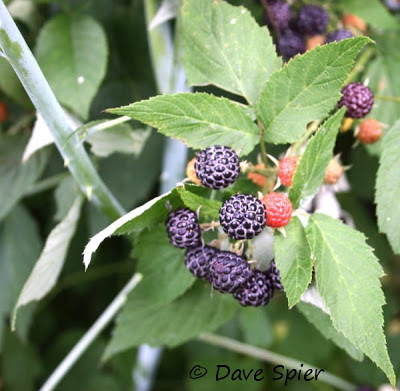 |
| Yummy |
I have mixed feelings about early July. On the down side are the humidity and the mosquitos (which seem to have reached a new peak). On the positive side, the wild Black Raspberries are ripe. For years, I've been encouraging these bushes to grow around the perimeter of our property. Even though they're thorny and often hook me on the arm or in the hair, the rewards seem to be worth it.
 |
| Black Raspberries are native to eastern North America. |
The common species is Rubus occidentalis, but similar varieties are numerous. They belong to the rose family, making them direct relatives of blackberries, strawberries, rose hips, cherries, plums, apples and pears. They are nicknamed "black caps" or "thimbleberries," referring to the way the ripe fruit separates easily from the pedicel leaving a round button called a carpel or receptacle (which seems misleading). True blackberries, a distinctly-different species, do not separate from the receptacle. Individual raspberry fruits are composite clusters of small beads called drupelets, each containing a tiny seed. The dark-purple color is produced by anthocyanin pigments which makes them useful as natural dyes -- witness the color of your fingers after picking a few. Raspberries are also healthy. The anthocyanins are powerful antioxidants and are being tested for their effect on cancer.
 |
| Raspberry canes have a whitish, powdery bloom, best seen at upper left |
It takes raspberry canes a year and a half to mature and bear fruit. The first year, the canes (green with a whitish, powdery coating) bear compound leaves usually with three leaflets but sometimes five arranged palmately (like fingers or spokes from a single point). The undersides of the toothed leaflets are silvery white, much like Silver Maple leaves. The second year, the canes turn dark purple or reddish, but the remaining powder makes them look bluish. They send out short branches that produce alternate, compound leaves with only three leaflets (unfortunately resembling poison ivy). Flowers with five white petals appear in May and these develop into red fruits which turn dark as they ripen around July 4th, give or take, here in the Finger Lakes region of New York. After the fruit is gone, you can still use the leaves to make tea.
 |
| The undersides of Black Raspberry leaves [turned over at right] are nearly white. |
The arching canes may root at the tip if they touch the ground. In this way, one shrub can form broad colonies that provide protective cover for small mammals. During the winter, the canes of all brambles (including dewberries, black and red raspberries and true blackberries) become food for cottontail rabbits. Canes die at the end of their second year, but the roots continue to send up new shoots every spring.
Black Raspberries are native from Wyoming to Ontario and Quebec and south to Georgia and Mississippi. If you live in this area and want to collect raspberries, you need to get to them before the songbirds, game birds and wild mammals of all sizes. If you want to grow your own, they tolerate a wide variety of conditions from open sunlight to shade and soils that are moist or dry. They will grow in open woods, thickets, stream banks, wet meadows and old fields as well as the edge of your lawn. If you leave a spot around some trees unmowed, the birds will probably drop some seeds and help you get started. In two years you'll be on your way to healthy eating.
Corrections, comments and questions are always welcome at northeastnaturalist@yahoo.com or connect through my Facebook page and photo page. There's also a community-type page for The Northeast Naturalist. Other nature and geology topics can be found on the parallel blogs Adirondack Naturalist and Heading Out.
No comments:
Post a Comment